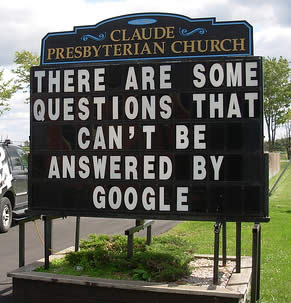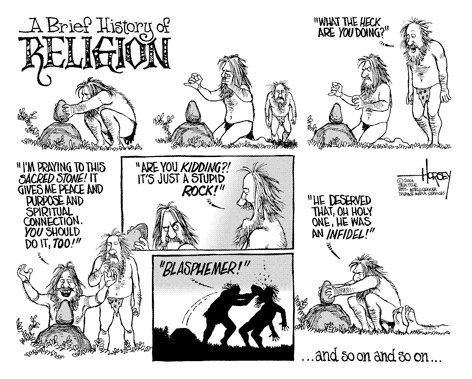COURSE OUTLINE
| Instructor: |
Dr. Ewa Wasilewska, Associate Professor/Lecturer, Dept. of Anthropology. |
| Contact information: |
Office: Stewart 101. By
appointment only.
Office phone: 801-581-6251. Please call between 8:00 a.m. and 5:00 p.m. and leave your name and a phone number so the instructor can call you back. Telephone appointments are acceptable.
Home phone: 801-596-3105. For emergencies only unless a telephone appointment is arranged.
Email: Mruczek@AOL.com
|
| Time: |
Tuesdays, 2:00 - 5:00 p.m. |
| Location: |
LCB 219 |
| Course description: |
This course will examine origin and meaning of two important concepts, “religion” and “religiosity,” and the affects their understanding, or lack of thereof, have on modern populations of the U.S.A. and the Middle East. It will discuss specific historical, economic, and political settings such as the emergence of monotheism, nationalism, terrorism, etc., in which these two concepts have been interchangeably used (or abused) for the real or perceived benefit of involved parties and for shaping their identities. Consequently, this course will introduce students to issues of religious diversity as perceived, practiced, and prescribed under rules of different religions within specific political, social, and cultural systems of these two regions. The stress will be put on mutual perceptions of the groups discussed (e.g., Jews, Christians, and Muslims) as insiders and/or outsiders of these systems. The course will provide students with a better understanding of present relations between the above religions, regions, and their representatives. |
| Disclaimer |
Some of the writings, lectures, films, or presentations in this course may include material that conflicts with the core beliefs of some students. Please review the syllabus carefully to see if the course is one that you are committed to taking. |
| Course objectives |
At the end of this course students will:
- Acquire knowledge of the Middle Eastern religions from the beginning of the written records to the rise of Islam.
- Be able to understand and discuss elements involved in defining and applying concepts of religion and religiosity with the special emphasis on the Middle East and the U.S.A.
- Learn about the U.S. strategic interests in the Middle East and mutual interdependence of these regions.
- Learn about numerous similarities in the official teachings of Judaism, Christianity, and Islam.
- Be able to discuss issues of self-identity within the framework of modernity and modernization.
- Be exposed to common misperceptions about discussed religious systems.
- Be able to analyze situations and stereotyping of religious minorities in the Middle East and the U.S.A. by the same groups but within different contexts.
- Become aware of the perceived double-standards of modern feminists (policy of appeasement toward some religious traditions vs hostility toward others).
- Be able to understand the impact of the media and various policies on creating negative images of religious minorities in the Middle East and the U.S.A. (e.g., Islam versus Christianity; “Jewish conspiracy,” etc.).
- Become acquainted with the history of conflict as based, presumably, on religion in the Middle East: its roots, continuation, and unpredictable future.
- Be exposed to the opposing views on identity, conflict, and adaptability of one’s beliefs in the “wars” on religion, about religion, and through religion. Religiosity at work.
- Be introduced to a variety of methods and theories employed in both social sciences and humanities when studying religion and/or religiosity. Their cognitive, conative and affective components will be presented, analyzed, and discussed using such methodologies as, for example, content analysis, comparative research, impact assessment and evaluation, etc., to provide students with tools to continue a basic research leading to practical goals they want to achieve in the future.
|
| Content Overview |
According to the World Religious Statistics monotheistic religions constitute 54% of all religious groups with Christianity and Islam being the leaders among them (Christianity –2.1 billion followers, Islam 1.5 billion, and Judaism 14 millions). All three leading monotheistic religions were “born” in the Middle East on the foundations of the earlier polytheistic beliefs of the area. All three systems have been feeding off each other throughout the history focusing more on their differences than similarities.
This course will focus on the similarities between these religious systems and point out perceived differences as not necessarily parts of the official teachings but rather of customary traditions of the region with a tumultuous history of itself. The very beginning of the concepts which create a drift in communication and mutual misunderstanding of religious moods and motivations will be presented and explained within the reality of modernity and modernization in both regions. The perceptions of the Christian minority in the Middle East and of the Islamic minority in the U.S.A. as well as of the Jewish minority in both, will be discussed and compared in view of existing legal and customary laws, economic and political realities, as well as of the social climate. The issues of nationalism, Islamophobia, Islamization, the so-called “Jewish conspiracy,” and terrorism will be discussed and traced back to their origins. |
| Teaching and Learning Methods |
This course is a combination of lectures and discussions. While each meeting will be illustrated with various visual aids, students will advised to search for additional visual material to better comprehend the discussed topics. While students are encouraged to initiate and participate in all discussions, they must remain respectful of all classmates and the professor. |
Evaluation Methods |
This course requires patience, a lot of tolerance and acceptance of all religious systems. Students are expected to:
-
Attend class meetings.
-
Do their readings in advance so they can fully participate in any discussions.
-
Take all required exams on time. Upon a valid request, special arrangements might be made with the professor (e.g., a different exam date).
-
Complete and turn in on time their assignments and/or papers.
-
Offer their opinions and argue their points. All must be done in good and edited English.
-
NO PLAGIARISM OR CHEATING IN ANY SHAPE OR FORM (see below: “Academic Misconduct”).
|
Exams, Assignments and Grades: |
Two in-class and one take-home exams are planned. However, in the event of an expansion of some topics due to students’ interest and/or current affairs, any in-class exam might be replaced with a take-home exam. Each exam counts for 25% of the final grade. 25% is allocated for a final project (a research paper) – a student’s independent research on a topic of his/her choice but approved by the professor.
There won’t be any extra-credit assignments in this class. Each exam and/or assignment and/or paper will be graded using the Letter-Grade scale (“A” as the highest, “E” as the lowest [no-pass] grade). The final grade will be calculated accordingly by setting up values of the Letter-Grade scale using the 4-Point scale. |
Required Format: |
A research paper and a take-home exam (see above) are to be submitted to the professor as hard copies and as electronic documents to http://www.turnitin.com
The required length of the research paper is 10 to 12 pages plus bibliography. The bibliography must include at least 4 additional (to the class material) sources such as scholarly articles and/or books. Internet sources such as Wikipedia are not acceptable.
The length of the take-home exam(s) will depend on a number (3 to 4) of essay questions and their topics. It is estimated that each question will require ca. two pages (typed, double-space, reasonable font and margins) with proper references to the class readings. Basic guidelines for writing a college paper can be found at http://www.collegeboard.com/student/plan/college-success/10358.html |
| Required Readings: |
All required articles, chapters from different books, etc., are listed under specific topics discussed during the semester. All of them are available at Marriott Library Reserve Desk through electronic reserve or as hard copies.
|

WEEK
# 1 - August 23, 2011
Course information.
The U.S., the Middle East, and the rest of the world: Strategic Interests and Globalization of Communication. National and Cosmopolitan Identities. The so-called L.A. (convergence), Taliban (polarization), and Bangalore (fusion) “Effects.” Is religion a subject to the same rules? 9/11 and the Mosque Controversy: fact, fiction, and emotions.
Readings for Week # 1: TBA

|
 |
|
| |
|
|
WEEK
# 2 - August 30, 2011
Defining “non-definable:” religion or religiosity? Religion as a cultural system. Religiosity as religion in practice. Self-identification: past and present. Is religion, or religiosity, a main factor or just one of them when defining oneself and others? The Middle East and the U.S.A. in numbers – statistical determinations.
Readings for Week # 2: TBA

|
 |
|
WEEK
# 3 - September 6, 2011
Ancient beliefs and traditions of the Middle East as the foundation of modern monotheistic systems. Re-interpretations of ancient themes.
Readings for Week 3 & 4: TBA

|
 |
|
WEEK
# 4 - September 12, 2011
Ancient beliefs and traditions of the Middle East as the foundation of modern monotheistic systems (continuation). Transition of “identities” as transformation of notions and understanding of fallibility of polytheistic deities and infallibility of monotheistic ones.
Readings for Week 4: see #3

|
 |
| |
|
WEEK
# 5 - September 20, 2011
WEEK
# 6 - September 27, 2011
The birth of the infallible god: the One and Only. Defining/explaining/understanding Judaism, Christianity, and Islam: inside and outside views under “Religious Tolerance Banner.” Formation of organized religions and foundations of modern manifestations of religiosity.
Readings for Week 6: TBA

|
 |
WEEK
# 7- October 4, 2011
The Paradise story: the original, alterations, adjustments, and 72 virgins. Defining the role of women in monotheistic societies: past and present. What does it mean to be a feminist? Contrasting views from the Middle East and U.S.A. Modern feminists and perceived misogynist practices in Judaism, Christianity, and Islam – equal treatment or yet another example of selected “causes” as shaped by religiosity?
Readings for Weeks 7 & 8: TBA

|
 |
WEEK
# 8 - October 11, 2011
FALL BREAK!!!

WEEK
# 9 - October 18, 2011
The Golden Age of Islam and the birth of martyrdom. Shahid – the witness to the truth or…? The Jihad, suicide bombers, and Christian saints – what do they have in common? The origin of such concepts as Dar al-Islam (“house of peace”) and Dar al-Harb (“house of war” also referred to as Dar al-Garb, “house of the West”), and their modern implications.
Readings for Weeks 9: TBA

|
 |
WEEK
# 10 - October 25, 2011
“The First Contact” in the name of One and Only. The Crusades and their legacy: setting foundations for future conflicts. Old memories, modern geopolitical and social realities.
Readings for Week 10: TBA

|
 |
WEEK
# 11 - November 1, 2011
Defining orientalism and nationalism: Western concepts or realities? One nationalism or many? Mythology of the homeland: reclaiming the past (“source countries”) to assert the present (modern states) and build the future.
Readings for Week 11: TBA

|
 |
 |
|
TAKE-HOME EXAM!!!
to be turned in on November 15, 2011
|
|
 |
WEEK
# 12 - November 8, 2011
Searching for identity: self-defining in the modern Middle East and U.S.A. A case for unity or disparity?
Readings for Weeks 12: TBA

|
 |
WEEK # 13 - November 15, 2011
In the name of freedom – fighting for God to live in heaven. Modern wars and other conflicts: lost hopes and/or new ideals? Part 1.
Readings for Week 13: TBA

|
 |
WEEK
# 14 - November 22, 2011
In the name of freedom – fighting for God to live in heaven. Modern wars and other conflicts: lost hopes and/or new ideals? Part 2.
Last day for a draft of a final paper!
Readings for Weeks # 14: see above

|


|
WEEK
# 15 - November 29, 2011
Public opinion: the world according to the media and crafty (or no so-crafty) politicians.
The Middle East and the U.S.A.: politics of terror, humor, or indifference? Search for effective (and affective) means of communication.
Readings for Week # 15: TBA

|
 |
WEEK
# 16 - December 6, 2011
Changing reality, changing proverbs: from “he who lives by the sword, shall die by the sword,” to “money is sharper than a sword.” A case for and against Jack Bauer.
“May be the Jew is right?” Steve Carell and Stephen Colbert on “Islam versus Christianity”. http://www.youtube.com/watch?v=uX-Aldx-LM0 The future of religiosity and/or conflict: Dar al-Islam, “Dar al-America,” or Dar al-‘Ahd (“house of truce”)?
Readings for Week # 16: TBA

WEEK
# 17 - December 13, 2011
 |
|
Final exam and the last day to turn a research paper in!!!
|
|
 |
 IMPORTANT!!! IMPORTANT!!!
ADA Statement:
“The University of Utah seeks to provide equal access to its programs, services and activities for people with disabilities. If you will need accommodations in the class, reasonable prior notice needs to be given to the Center for Disability Services, 162 Union Building, 581-5020 (V/TDD). CDS will work with you and the instructor to make arrangements for accommodations.” (www.hr.utah.edu/oeo/ada/guide/faculty)
Faculty Responsibilities:
“All students are expected to maintain professional behavior in the classroom setting, according to the Student Code, spelled out in the Student Handbook. Students have specific rights in the classroom as detailed in Article III of the Code. The Code also specifies proscribed conduct (Article XI) that involves cheating on tests, plagiarism, and/or collusion, as well as fraud, theft, etc. Students should read the Code carefully and know they are responsible for the
content. According to Faculty Rules and Regulations, it is the faculty responsibility to enforce responsible classroom behaviors, and I will do so, beginning with verbal warnings and progressing to dismissal from and class and a failing grade. Students have the right to appeal such action to the Student Behavior Committee.” (www.admin.utah.edu/ppmanual/8/8-12-4.html)
ACADEMIC MISCONDUCT
Please familiarize yourself with the University of Utah CODE OF STUDENT RIGHTS AND RESPONSIBILITIES (“STUDENT CODE”) at www.admin.utah.edu/ppmanual//8/8-10.html
The following is an excerpt from this CODE explaining specific actions, which won’t be tolerated in this class.
“2. “Academic misconduct” includes, but is not limited to, cheating, misrepresenting one's work, inappropriately collaborating, plagiarism, and fabrication or falsification of information, as defined further below. It also includes facilitating academic misconduct by intentionally helping or attempting to help another to commit an act of academic misconduct.
a. “Cheating” involves the unauthorized possession or use of information, materials, notes, study aids, or other devices in any academic exercise, or the unauthorized communication with another person during such an exercise. Common examples of cheating include, but are not limited to, copying from another student's examination, submitting work for an in-class exam that has been prepared in advance, violating rules governing the administration of exams, having another person take an exam, altering one's work after the work has been returned and before resubmitting it, or violating any rules relating to academic conduct of a course or program.
b. Misrepresenting one's work includes, but is not limited to, representing material prepared by another as one's own work, or submitting the same work in more than one course without prior permission of both faculty members.
c. “Plagiarism” means the intentional unacknowledged use or incorporation of any other person's work in, or as a basis for, one's own work offered for academic consideration or credit or for public presentation. Plagiarism includes, but is not limited to, representing as one's own, without attribution, any other individual’s words, phrasing, ideas, sequence of ideas, information or any other mode or content of expression.
d. “Fabrication” or “falsification” includes reporting experiments or measurements or statistical analyses never performed; manipulating or altering data or other manifestations of research to achieve a desired result; falsifying or misrepresenting background information, credentials or other academically relevant information; or selective reporting, including the deliberate suppression of conflicting or unwanted data. It does not include honest error or honest differences in interpretations or judgments of data and/or results.”
The following sanctions will be imposed in this class for a student engaging in academic misconduct:
1. A failing grade for the specific assignment, paper, exam, etc., without possibility to re-write it, re-take it, etc. This academic misconduct will be reported to the Chairman of the Department of Anthropology.
2. The second offense will be sanctioned with a failing grade for the whole course. In such a case, the following rule of the University of Utah CODE OF STUDENT RIGHTS AND RESPONSIBILITIES is applicable and will be followed: “If the faculty member imposes the sanction of a failing grade for the course, the faculty member shall, within ten (10) business days of imposing the sanction, notify in writing, the chair of the student’s home department and the senior vice president for academic affairs or senior vice president for health sciences, as appropriate, of the academic misconduct and the circumstances which the faculty member believes support the imposition of a failing grade.”
3. For more information concerning sanctions for academic misconduct (additional sanctions might be imposed) and your rights and procedures to appeal these sanctions please refer to the aforementioned CODE.
If you need more information and/or explanations please don’t hesitate to contact the instructor.
Ewa
Wasilewska's Home Page
|

































